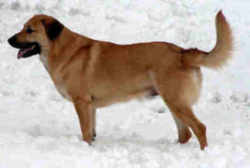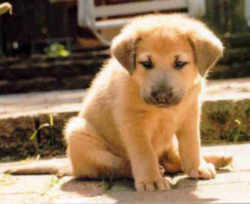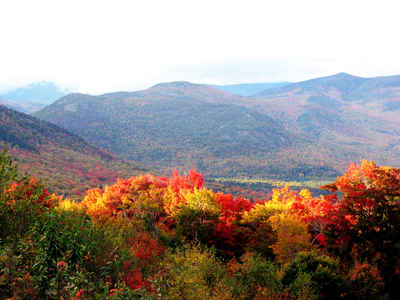New Hampshire State Dog
Chinook

(C. l. familiaris)
Adopted in 2009
The Chinook was designated as the official state dog of New Hampshire in 2009.
The Chinook, a sled and work dog, is the only breed to have originated in New Hampshire and one of the few created in America. The breed was started by Arthur Walden in Wonalancet New Hampshire in 1917.
The bill was the idea of a group of seventh graders at the Ross A. Lurgio Middle School in Bedford.
Chinook: New Hampshire State Dog

The Chinook was developed in New Hampshire as a sled dog whose function was drafting and sled dog racing. Bred to combine the power of freighting breeds with the speed of the lighter racing sled dogs, he is an athletic, hard bodied dog. The Chinook, whose name means 'warm winter winds' in Inuit, was named New Hampshire's State Dog in 2009. The breed has a thick, tawny-colored (ranging from pale honey to a deep reddish-gold) double coat lying close to the body.
The Chinook is one of the few American dog breeds. It was developed by Polar Explorer Arthur Treadwell Walden during the early 1900's by blending a Mastiff type dog with Greenland Husky as well as German and Belgian Shepherds. Walden created a sled dog with endurance, trainability, and a gentle nature. In 1940, Perry and Honey Greene purchased the Chinooks and promoted them for many years, becoming the sole producers of the breed. By 1965, the Guinness Book of World Records recorded the Chinook as the rarest dog in the world, but with the dedication of Chinook fanciers, there are now hundreds of Chinooks listed with the AKC.
Characteristic of New Hampshire Chinook

The Chinook has a compact muscular frame that well suits this gentle sled dog. The body is well balanced; the chest is deep; moderate bone and flexible musculature are prominent. The skin on the head is tight with no wrinkles. The stop is moderate and there is a furrow running vertically from the stop to the occiput. The muzzle is powerful and the teeth are enduring. The breed's ear carriage, rather wind-blown and bending, gives the dogs a curious and entreating glint; however, the ears can also be pricked up. The nose has large wide nostrils, should be solid black, and project slightly over the mouth. The lips are black in color. The top lip overhangs the lower lip very slightly and the corners of the lower lip are slightly pendulous. The teeth meet in a scissors bite. The eyes are almond-shaped and of moderate size, with an intelligent expression. Dark brown eyes are preferred, but lighter, amber eyes are acceptable. Eye rims are dark-pigmented. The feet are oval, firm and compact, with well-knit, well-arched toes and tough, deeply cushioned, darkly-pigmented pads. The toes are moderately webbed and the feet are well-furred, even between the toes. The front feet turn slightly outward. Dewclaws can be removed from the front feet and, if present, are usually removed from the back feet. The tail is thick at the root and tapers to the tip. When the dog is standing, the tail hangs downward, approximately to the hocks. When the dog is moving, the tail is carried up. The Chinook tail is never docked. Chinooks have a double coat of medium length hair. The undercoat is thick, soft, and downy in texture. The outer coat is coarse and the hair lies close to the body. Less dense coats are normal in very warm climates. The neck is well-furnished with hair, which forms a protective ruff blending into the apron. The tail is well-furred, with longer hair at the base and underside of the tail. The groin and inside of the rear legs are protected by the coat. In color, the Chinook is tawny (a golden fawn).
With his heritage as a hard-working sled dog, the Chinook is intelligent and easy to train if you use positive reinforcement techniques, such as
praise, play, and food rewards. If you lead an active, outdoorsy lifestyle, this is the dog for you. Chinooks are great companions for hikers and backpackers,
and they thrive at dog sports, including sledding and skijoring. They also perform well in agility, herding, obedience, and rally.
For all his positives, the Chinook does come with a couple of caveats: He requires intense levels of daily exercise, and his high intelligence can
work against you - a bored Chinook can be incredibly destructive when left to his own devices, reinforcing his people-loving nature.
New Hampshire General Laws
The law designating the chinook as the official New Hampshire state dog is found in the New Hampshire Statutes, Title 1, Chapter 3, Section 3:25.
TITLE I
THE STATE AND ITS GOVERNMENT
CHAPTER 3
STATE EMBLEMS, FLAG, ETC.
Section 3:25
3:25 State Dog. - The chinook is hereby designated as the official state dog of New Hampshire.
Source. 2009, 62:1, eff. Aug. 7, 2009.
Taxonomic Hierarchy: Chinook Dog
Kingdom: Animalia
Phylum: Chordata
Class: Mammalia
Order: Carnivora
Family: Canidae
Genus: Canis
Species: C. lupus
Subspecies: C. l. familiaris








